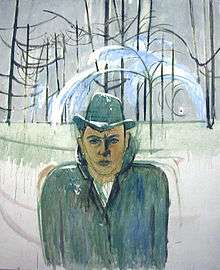Walter Kurt Wiemken
Walter Kurt Wiemken (14 September 1907 – 30 December 1940) was a Swiss painter.
| Walter Kurt Wiemken | |
|---|---|
 | |
| Born |
14 September 1907 Basel, Switzerland |
| Died |
30 December 1940 (aged 33) Castel San Pietro, Switzerland |
| Nationality | Swiss German |
| Known for | Painting |
Life
Walter Kurt Wiemken was born in Basel in 1907 to German parents who had gained Swiss citizenship in 1898. Wiemkin became seriously ill with polio at the age of four months old, which led to a life-long disability. He lived in his parents' home until his death and also built his art studio there. Wiemken's father owned a lithography business.
Wiemken studied at the vocational school in Basel from 1923 to 1927, where his graphics teacher was the painter Fritz Baumann, the founder of the Expressionist artist group "Das neue Leben" ("The new life"). Accordingly, Wiemken's illustrations from this time show a clear Expressionist influence. Wiemken sought the friendship of the Rot-Blau artist group, which had been founded by students of Ernst Ludwig Kirchner.
In 1927 Wiemken spent the summer semester at the State University of Applied Arts in Munich, where he was taught by Fritz Hellmut and Richard Klein. After his stay in Munich, Wiemken travelled to Paris with painter Otto Abt, where he made his last Expressionist pictures. These were almost exclusively gloomy street scenes. After this, Wiemken turned towards Impressionism. In 1928 and 1929 Wiemken travelled to the artist colony of Collioure in Roussillon and to Ticino with lifelong friends Abt and Walter Bodmer. During these trips he painted extraordinary landscapes. Wiemken and his friends visited Collioure several times until 1939.
Watching a young girl's burial take place whilst a butcher was going about his daily work had a strong impact on Wiemken's creative output. From then onwards, he aimed to represent the dichotomy of these simultaneous events of human life in his paintings. In the 1930s Wiemken's art was influenced by the work of Serge Brignoni, Kurt Seligmann and Pablo Picasso, who in turn had been influenced by Surrealism. His work was characterised by showing both the light and dark sides of humanity. In 1936 Wiemken took part in the exhibition "Zeitprobleme in der Schweizer Malerei und Plastik" ("Time problems in Swiss painting and plastic arts") at the Kunsthaus Zürich.
In 1933 Wiemken co-founded the artist group Gruppe 33 with his friends Abt and Bodmer, a protest against conservative trends in Swiss art and architecture (especially in Basel). Gruppe 33 were also staunchly anti-fascist. From 1936 to 1937 Wiemken was influenced by his friend Bodmer's constructivist art. He travelled to Belgium in 1937 and became interested in the surrealist art of James Ensor.
On 30 December 1940 Wiemken died after falling into the Breggia Gorge in Castel San Pietro during a walk alone. His corpse was not found until 23 January 1941.
Wiemken's work was internationally praised and exhibited. His work was also included in documenta 1 in Kassel in 1955.
References
- Erinnerungen an Walter Kurt Wiemken von Walter Bodmer und Otto Abt. Œvrekatalog von Helene Sartorius und Claus Krieg. Holbein, Basel 1942.
- Beat Wismer, Paul-André Jaccard: Werke des 20. Jahrhunderts – Von Cuno Amiet bis heute. Sammlungskatalog Aargauer Kunsthaus Aarau, Aarau 1983.
- Harald Szeemann (Ed.): Visionäre Schweiz im Kunsthaus Zürich. Sauerländer, Aarau 1991, ISBN 3-7941-3437-0.
-

Wikimedia Commons has media related to Walter Kurt Wiemken. - Literature by and about Walter Kurt Wiemken in the German National Library catalogue
- Template:Documenta Archiv
- "Wiemken, Walter Kurt". SIKART dictionary and database.
- This article was initially translated from the German Wikipedia.